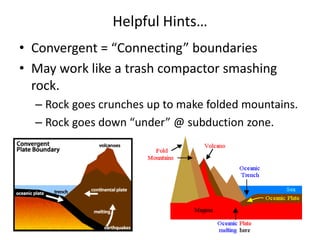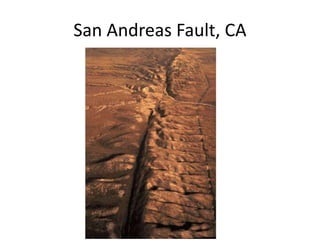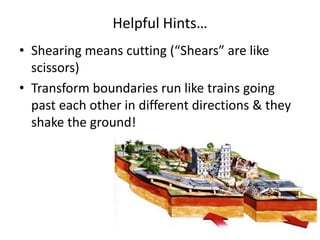Plate Tectonics2.ppt
- 1. The Theory of Plate Tectonics - Boundaries, Stresses, and Faults 1. What is the theory of plate tectonics? 2. What are the three types of plate boundaries?
- 2. What are Plates? • The Earth’s crust and upper mantle (Lithosphere) are broken into sections called plates A section of the lithosphere that slowly moves over the asthenosphere, carrying pieces of continental and oceanic crust. Plates move around on top of the mantle like rafts
- 3. What is the Theory of Plate Tectonics? The theory that pieces of Earth’s lithosphere are in constant motion, driven by convection currents in the mantle. • Plates move slowly in different directions Cause different geologic events (like earthquake, volcano, etc.)
- 4. What makes the plates move? Convection Currents in the mantle move the plates as the core heats the slowly-flowing asthenosphere (the elastic/plastic-like part of the mantle).
- 6. FAULT – Breaks in Earth’s crust where rocks have slipped past each other. The edges of Earth’s plates meet at plate boundaries. Extended deep into the lithosphere
- 7. What are the three types of boundaries? • Divergent Boundaries • Convergent Boundaries • Transform Boundaries
- 8. Divergent Boundaries A plate boundary where two plates move away from each other. RIFTING causes SEAFLOOR SPREADING
- 9. How is the rock pulled at Divergent Boundaries? Rock gets THIN in the middle as it is pulled apart. This STRESS is called
- 10. What happens when the rock SNAPS from the Stress of Tension? A Normal Fault (fault is a break in Earth’s crust) Rock drops down as it breaks
- 11. What happens next at Divergent Boundaries? • A geologic feature or event… May form RIFT VALLEYS on continents SEA-FLOOR SPREADING in the ocean
- 12. Helpful Hints… • Divergent is like “dissecting” or “dividing” • If you pull warm bubble gum or silly putty, it will thin in the middle until it is stressed so much that it breaks. • Happens on land & under H2O
- 13. Features of Divergent Boundaries • Mid-ocean ridges • rift valleys • fissure volcanoes
- 14. How is the rock pushed at convergent boundaries? A plate boundary where two plates move towards each other. Boundaries between two plates that are colliding This stress is called COMPRESSION
- 15. Convergent Boundaries • Places where plates crash (or crunch) together or subduct (one sinks under)
- 16. There are 3 types of Convergent Boundaries… Ocean plate colliding with a less dense continental plate Subduction Zone: The process by which oceanic crust sinks beneath a deep-ocean trench and back into the mantle at a convergent plate boundary.
- 17. There are 3 types of Convergent Boundaries…
- 18. What else happens at Convergent Boundaries? VOLCANOES occur at subduction zones
- 19. Andes Mountains, South America
- 20. • Ocean plate colliding with another ocean plate • The less dense plate slides under the more dense plate creating a subduction zone called a TRENCH
- 22. • A continental plate colliding with another continental plate • Have Collision Zones: –A place where folded and thrust faulted mountains form.
- 23. • May form Mountain Ranges. These are Folded Mountains, like the Himalayas or the Rockies.
- 24. What happens when the rock is squeezed from the Stress of Compression? • A REVERSE FAULT • Rock is forced upward as it is squeezed.
- 25. Helpful Hints… • Convergent = “Connecting” boundaries • May work like a trash compactor smashing rock. – Rock goes crunches up to make folded mountains. – Rock goes down “under” @ subduction zone.
- 26. Transform Boundaries A plate boundary where two plates move past each other in opposite direction.
- 27. How is the rock broken at Transform Boundaries? • Rock is pushed in two opposite directions (or sideways, but no rock is lost) • This stress is called SHEARING
- 28. What happens next at Transform Boundaries? • May cause Earthquakes when the rock snaps from the pressure. • A famous fault @ a Transform Boundary is the San Andreas Fault in California.
- 29. San Andreas Fault, CA
- 30. What happens when the rock is sheared (or “cut”) from the Stress of Shearing? • A STRIKE-SLIP FAULT • Rocks on each side of the fault slip past each other as they break.
- 31. Helpful Hints… • Shearing means cutting (“Shears” are like scissors) • Transform boundaries run like trains going past each other in different directions & they shake the ground!
- 32. Can you match the boundary name correctly with its diagram? A._____________ B._____________ C._____________ Plate Boundaries:
- 33. Plate Boundaries: • Correct Answers: A.Divergent B.Convergent C.Transform
































